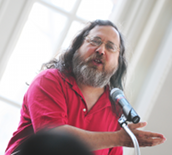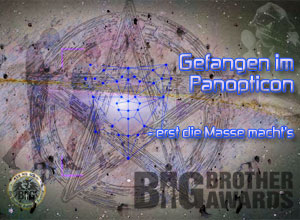

|
search / subscribe / upload / contact |
|
|
||
|
|
||
|
|
||
|
|
||
|
|
||
|
|
||
|
|
||
|
|
||
| RSS-Feed Depeschen | ||

|
||
Date: 2001-02-10
UK/USA: MI5 & MI6 & Troubles fuer Cryptome-.-. --.- -.-. --.- -.-. --.- -.-. --.- -.-. --.- -.-. --.- mit jenen Nachrichtendiensten, die global mit den merkbar übelsten Manieren ausgestattet sind: den Briten. John ist der Ansicht, dass in der herauf/dämmernden Informationsgesellschaft Normalsterblichen so viele Nachrichten wie möglich über die Aktivitäten geheimer Nachrichtendienste zur Verfügung stehen sollten. Nach den vorherigen Bröseln mit MI5 scheint nun die Truppe, die am gegenüberliegenden Ufer der Themse residiert, nämlich MI6, hauptsächlich involviert zu sein. post/scrypt: John, der Deutsch liest, ist seit den Anfangstagen auf dieser Liste subscribiert. http://cryptome.org/fru-walshaw.htm -.-. --.- -.-. --.- -.-. --.- -.-. --.- -.-. --.- -.-. --.- Relayed by Declan McCullagh <declan@well.com> -.-. --.- -.-. --.- -.-. --.- -.-. --.- -.-. --.- -.-. --.- John Young, who operates the cryptome.org document archive, says the British government is applying pressure to his ISP to censor a news article on his site titled "Enquiry: The Killing Years in Ireland." He believes London has somehow gained access to his log files -- cryptome.org is hosted by Verio -- and has handed that information to reporters. This comes after prior run-ins that John has had with MI5: http://cryptome.org/mi5-verio.htm More on John Young: http://www.mccullagh.org/cgi-bin/photosearch.cgi?name=john+young ENQUIRY : THE KILLING YEARS IN IRELAND 3 February 2001 By ANON = MAHARAJAH British journalists, police officers and Army undercover intelligence agents are increasingly in battle with each other as an intelligence scandal threatens to expose a series of state-sponsored killing of the kind more commonly associated with former South American dictatorships than with a modern western European nation. For the last two years, British security authorities have resorted to legal duress and intimidation tactics to conceal the identity and activities of Army intelligence operators who played a key role in a secret unit that set up innocent civilians to be murdered, actively collaborated with and fed intelligence to death squads, and then set fire to police offices to destroy their files and prevent an investigation uncovering their activities. The secret unit, called the Force Research Unit (FRU) was a high level intelligence unit tasked with handling undercover agents in Northern Ireland and the Irish Republic. It was set up in the early 1980s to take over previously unco-ordinated agent running activities, placing them all under a single professional command structure. The lawless misconduct of FRU has come to light over the last two years as a result of an extended police enquiry into controversial assassinations by the Protestant terrorist organisation, including the Ulster Defence Association (UDA). The enquiries originally focussed on the slaying of prominent republican lawyer Pat Finucane in February 1989. It has since emerged that Finucane's killing was planned by the UDA's intelligence officer, Brian Nelson. But, unknown to his terrorist colleagues, Nelson was a British intelligence agent. He was being run by the FRU, to whom he reported routinely, exchanging information on republicans whom the UDA sought to kill. The UDA's quartermaster, William Stobie, who provided the murder weapons and hid them afterwards, was also a British agent. He worked for the Special Branch of the Royal Ulster Constabulary, the police force of Northern Ireland. Former members of the FRU have told journalists that up to 13 Irish Catholics were killed in this way. One case which came to light last year was the 1987 murder of a Catholic pensioner living in West Belfast, Francisco Notorantonio. Notorantonio, aged 66 when he died, had not been involved in politics for 30 years. He was set up to be killed by the FRU, as a sacrificial victim to protect a top British agent. Shortly before the murder, FRU had been informed of a plan to kill a leading member of the IRA, who was secretly a British intelligence agent. Codenamed STAKEKNIFE, the agent was and still is British intelligence's longest term and most successful informant inside the Irish terrorist group. When they learned of the plot, the FRU panicked. To head the killers away from STAKEKNIFE, they prepared and handed over a false dossier, suggesting that the innocent and harmless Notorantonio would be a better target for their bullets. The existence and importance of Agent STAKEKNIFE has recently been publicly confirmed by the police investigation which is determined to undercover the truth of the FRU affair. The investigation is headed by Sir John Stevens, the Commissioner of the Metropolitan (London) Police. He is Britain's most senior police officer. Ten years earlier, when he was in a less senior position, Stevens was first asked to investigate the killings in Northern Ireland. As he and his team started to uncover the nature of Army collusion with protestant terrorists, he faced an arson attack. The teams' offices, which were located in a highly secure police headquarters building with multiple alarm systems, went on fire, destroying the files. The attack effectively brought Stevens' first enquiry to a fruitless end. The mystery of how sophisticated alarms had been disabled to get in and burn the files was solved when a former member of the FRU came forward and revealed that they had been responsible for the crime. The breaking, entering and fireraising had been carried out by a team from Army intelligence's CME (Covert Methods of Entry) unit. Called in by the FRU commander to destroy the incriminating evidence accumulating in police hands, the CME team flew in from England and carried out the arson attack on the police. They crudely attempted to disguise the fire as having been started by a cigarette left in a waste bin. Three years ago, Sir John Stevens, now promoted to be the commissioner of the Metropolitan police, was asked to conduct another enquiry into collusion in Northern Ireland, focusing on the murder of Patrick Finucane. Since then, he and his operational assistant, Deputy Assistant Commissioner Hugh Orde, have made it clear that they are not going to be deflected by Army dirty tricks and disinformation. The former soldier who came forward used the pseudonym "Martin Ingram". The Ministry of Defence responded ferociously. One soldier whom they believed to be Ingram was charged under the Official Secrets Act. Journalists to whom he spoke were threatened with prosecution. The charges meant that while one police enquiry was relying on him as a key witness, another police enquiry was trying to silence him. But, with increasing controversy surrounding British secrecy laws, the charges against "Ingram" had to be dropped. Harassment then started from a new quarter. A group calling itself "friends of FRU" started circulating personal information about him. One former FRU colleague e-mailed dozens of newspapers giving details of "Ingram" 's identity, address and activities. He was being set up. The former FRU soldier behind the e-mail campaign was arrested for harassment. But then the charges were dropped. Fearing that the police could not protect him safely, "Ingram" withdrew his evidence from the Stevens enquiry. Two weeks ago on Ulster Television, another member of FRU came forward to talk about what the unit had done. Agreeing that there had been a policy of "shoot to kill by proxy", the former the FRU member said that his unit had acted as "judge, jury and executioner ... [it was] immoral and probably unlawful". FRU is still operating, running agents in Ireland. Since it became controversial, it has adopted a new cover name. This is JCU(NI). It stands for the Joint Collection Unit (Northern Ireland). It works directly with the British Security Service ("MI5"), which also has offices and technical teams on the ground in Northern Ireland. To confuse the many British journalists who are now investigating the activities of FRU, another intelligence unit was renamed FIU. This is the Force Intelligence Unit. It has nothing to do with FRU, but runs more orthodox intelligence activities, such as the computer called CAISTER which holds "fine grain" intelligence files on most of the Northern Ireland population. It was formerly called 12 Intelligence Company. A third group in the undercover world of Northern Ireland is the Joint Support Group (JSG). Formerly known by a variety of names such as "14 Intelligence Company" or "The Dets", it provides undercover surveillance teams for long-term surveillance activities. Its teams work closely with the SAS detachment based in Northern Ireland. Until now, mystery has surrounded the identity of the agent handler who was Brian Nelson's link to the Army and who passed on the critical instructions and government intelligence to enable the protestants to murder the Army's selected targets. But the name leaked out late last year. Early in December, the government threatened legal action to gag the Sunday Herald, a Scottish newspaper, after former colleagues of Nelson's handler revealed her identity to their journalists. The paper was compelled under threat of legal order to undertake that it would not reveal her name, location or identify her by printing a photograph. Then the case for conspiracy to murder against her and the officers who gave her orders grew stronger, after police Commissioner Orde revealed that he had recovered boxes of army intelligence documents called "contact forms" and MISRs (Military Intelligence Source Reports). The contact forms give details of every meeting between agents and their handlers. The MISR reported detailed and assessed the intelligence provided by the agents. The police found that some of the reports were "incriminating". The officer who commanded the Force Research Unit during the killing years was Lt Colonel Gordon Kerr. He has since been promoted to Brigadier. As the British police homed on his importance, he was sent to the other side of the world, to serve as the British military attaché in Beijing. The intelligence operator who handled Brian Nelson - whose name is banned in Britain - is Captain Margaret Walshaw. Although any British newspaper editor who published her name is threatened with imprisonment, she is openly listed in the current official British government publication, the "Army List". At the time she ran agent Brian Nelson and supervised his murderous activities, she was a non commissioned officer (sergeant) in Britain's Intelligence Corps. On 1st April 1998, Sergeant Walshaw was promoted from the ranks to become an officer. She has also been awarded the "British Empire Medal" for her achievements. -.-. --.- -.-. --.- -.-. --.- -.-. --.- -.-. --.- - -.-. --.- -.-. --.- -.-. --.- -.-. --.- -.-. --.- -.-. --.- edited by published on: 2001-02-10 comments to office@quintessenz.at subscribe Newsletter - -.-. --.- -.-. --.- -.-. --.- -.-. --.- -.-. --.- -.-. --.- |
|
|
|
| CURRENTLY RUNNING | |
q/Talk 1.Juli: The Danger of Software Users Don't Control

|
|
| !WATCH OUT! | |
bits4free 14.Juli 2011: OpenStreetMap Erfinder Steve Coast live in Wien

|
|

